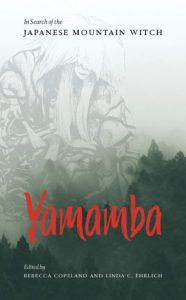(Stone Bridge Press, June 22, 2021)
Review by Jann Williams
Over two-thirds of Japan is covered with forested mountains. Traditionally these are sacred places, viewed as dwelling places of the dead and ancestral spirits, and as a liminal space between this world and the other world. Yama, the Japanese word for ‘mountain,’ is reflected in the words yamabushi—an ascetic practitioner who “lies or prostrates on the mountain”— and yamamba, the mountain witch, crone or hag of folklore that is the focus of this anthology.
Since the name yamamba first appeared in the Muromachi period (1336-1573) the mountain witch has appeared in many guises. Depending on the circumstances, she can both ignite fear or perform acts said to transcend ordinary kindness. Yamamba is one of the best known yōkai (strange or mysterious creatures) in Japan and continues to be reimagined in contemporary times. Yamamba’s identity is intimately connected to mountains, nature, the feminine/other as well as the duality of good and evil throughout this fascinating volume.
Yamamba expert Noriko T. Reader sets the scene for Yamamba: In Search of the Japanese Mountain Witch, a collection of poems, interviews, short stories and commentary. The style of each contribution is used as the heading in the Table of Contents, which makes it possible to dip in and out of the book according to one’s inclination. If one feels like reading poetry for example, it is easy to locate the two delightful chapters in (translated) verse. Or if one is hankering for a short story, there are three to select from. At 152 pages, it is just the right length for the combination of literary styles.
The anthology, co-edited by , features authors who range from academics to performance artists in both North America and Japan. Several of the entries are translated from Japanese, and one poem has been translated into Japanese. With a limited number of illustrations, readers are left to imagine the yamamba in her various forms; the freedom to do so adds depth to the reading experience. The diverse perspectives and categories are presented as “a sampling of the awe the yamamba inspires with her power.” This yōkai certainly taps into the deeper recesses of our ‘being’.
Two seminal Japanese works are highlighted in the anthology: one composed in the early 14th century, the other in 1976. The Noh play “Yamamba,” attributed to Zeami Motokiyo, has been regularly performed for centuries. The story tells of the meeting in the mountains between a real yamamba and an actress who plays yamamba. Hisa and Hikaru Uzawa, two contemporary Noh artists who know the play intimately, are interviewed and their contribution is my personal favourite. Along with a recent review of Noh As Living Art, the portrayal of this noh play has inspired me to further explore this Japanese art form.
“The Smile of the Mountain Witch,” a story by the highly respected female writer Oba Minako, provides a feminist perspective on the yamamba. This 1970s work was the starting point for the anthology and is reproduced within its pages. In the Preface, the editors powerfully state that Oba-san “reveals the compelling way creative women can take charge of misogynistic tropes, invert them, and use them to tell compelling stories of female empowerment.” This new narrative shows a different and more intimate side of the yamamba. The ability of the mountain witch to read people’s minds is used with great effect in Oba-san’s story.
Komatsu Kazuhiko states in his preface to the English edition of An Introduction to Yokai Culture that “a deeper knowledge of yōkai is a prerequisite for a deeper understanding of Japanese culture as a whole” In that spirit, I feel much better acquainted with the yamamba, especially her representation of nature and the seasons, and as a woman living outside the norms of village or city life. Her role as an archetype is also addressed in the anthology, another aspect of this complex character.
No longer will I view this yōkai as an unsightly old woman who lives in the mountains and devours humans, as she is popularly characterised. Readers can discover her many dimensions and multiple layers as seen through the words of an impressive group of authors. For those wanting to learn even more, a comprehensive reading list is provided at the end of the book.


